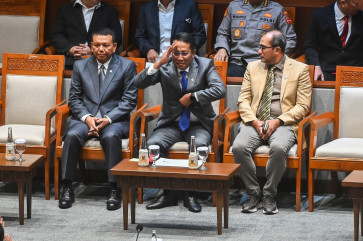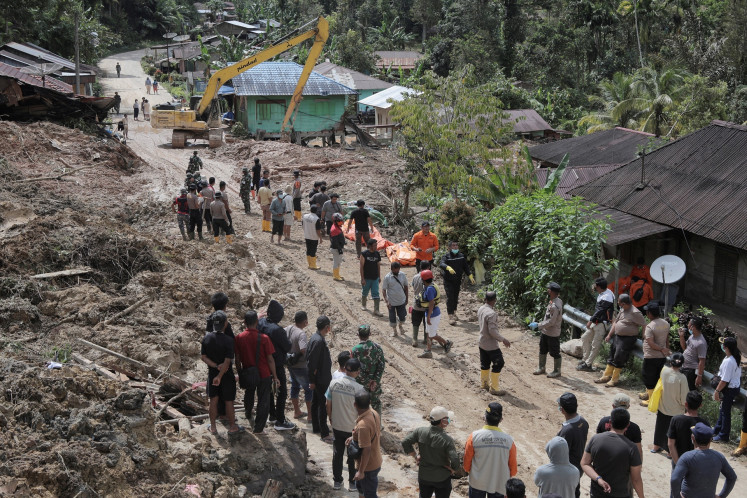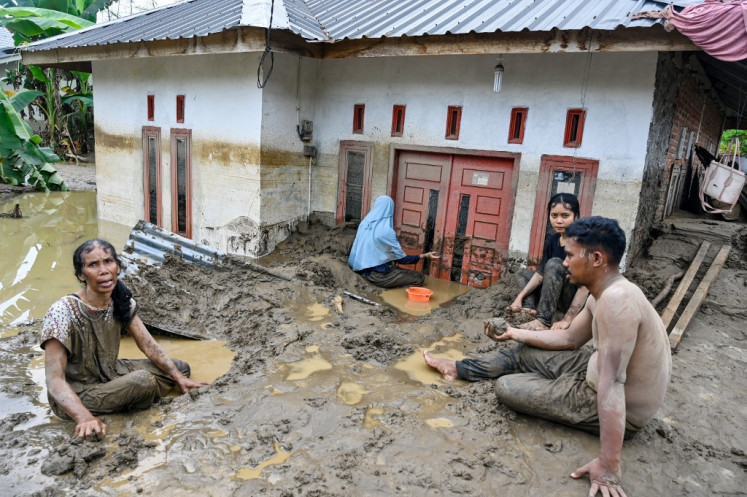Popular Reads
Top Results
Can't find what you're looking for?
View all search resultsPopular Reads
Top Results
Can't find what you're looking for?
View all search resultsRain starts to extinguish forest fires
The downpours that have been falling for five straight days in parts of the country have begun to reduce the number of hot spots indicating forest fires scattered throughout the archipelago
Change text size
Gift Premium Articles
to Anyone
T
he downpours that have been falling for five straight days in parts of the country have begun to reduce the number of hot spots indicating forest fires scattered throughout the archipelago.
National Disaster Mitigation Agency (BNPB) spokesman Sutopo Purwo Nugroho said on Saturday that the combination of artificial rain and natural rain falling across Sumatra and Kalimantan from Oct. 26 had helped tremendously in fighting the raging forest fires.
'All indicators, such as hot spots, visibility and air quality have improved significantly,' he said. 'If previously, the number of hot spots amounted to thousands, for example 2,218 on Oct. 24, today it's only 402.'
The rain, which has followed the prolonged dry season resulting from the El Niño weather phenomenon, also helped increase the visibility in many major cities in Sumatra and Kalimantan.
'If in the past it was less than 500 meters on average, now it's already much better,' Sutopo said.
The visibility in Padang, West Sumatra, was 4,000 m; 7,000 m in Pekanbaru, Riau; 2,800 m in Jambi; and 800 m in Palembang, South Sumatra on Sunday.
Kalimantan reportedly enjoyed better visibility on Saturday: 2,000 m in Pontianak, West Kalimantan; 1,500 m in Palangkaraya; and 6,000 m in Banjarmasin, South Kalimantan.
The Meteorology, Climatology and Geophysics Agency (BMKG) predicted that the rain would last until this weekend and thus the government is intensifying its cloud seeding effort to induce more rain.
The fires raging across land and forests in Indonesia have destroyed more than 2 million hectares of land in three months, earning them the accolade of one of the worst ecological disasters in human
history.
According to the National Institute of Aeronautics and Space (Lapan), 2,089,911 ha had been scorched by the ongoing fires from June 1 to Oct. 20.
'If we break down the figure, 600,000 ha of peatland and 1.5 million ha of other types of land [have been burned],' said Parwati Sofan, head of the environmental and disaster mitigation division at Lapan, in Jakarta on Friday.
Two million ha is the equivalent of 1.9 million soccer fields, or 32 times the area of Jakarta or four times the size of Bali.
Both Sumatra and Kalimantan, the two regions where the annual forest fires usually occur, were hit the hardest, with 832,999 ha and 806,817 ha of land burned in those areas, respectively.
However, Papua, which usually does not suffer from forest fires, had the third-largest area of burned land with 353,191 ha.
Moreover, Papua province was the province with the second-largest burned area with 344,980 ha, only surpassed by South Sumatra with 359,100 ha.
'If we look at past years, such as in 2013 and 2014, there were no forest fires [in Papua], but suddenly it ranked third [in size of burned land]. There must be something,' Sutopo said on Friday.
He said the sudden appearance of forest fires in Papua might have something to do with a massive agricultural project called the Merauke Integrated Food and Energy Estate (MIFEE) program.










